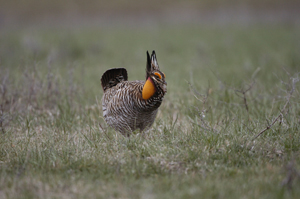April 14, 2011
Saving the prairie chicken: Work in Kansas has national significance for declining species of grassland bird

The greater prairie chicken is a declining species across the nation, but studies by researchers at Kansas State University may help boost its numbers.
"Kansas has national importance as a stronghold for some of the largest remaining populations of prairie chickens in the United States," said Brett Sandercock, an associate professor of biology who studies the behavior of the birds.
Sandercock and his research team are especially busy with field work in the spring. It's mating season for the prairie chickens, which usually arrive at their breeding or booming grounds, also called leks, shortly before dawn and stay only a few hours.
"Right now this means we have to get up at 5 a.m. to arrive at the leks by 6 a.m., with the birds coming in between 6:15 and 6:30 a.m.," he said. "Prairie chickens will come into the leks in the evenings too, but are usually less active."
Prairie chickens have been declining for the past 30 years. Low populations in other states have been linked to inbreeding and low egg viability. "High testosterone levels can increase the chance that a male mates with a female but also may reduce survival through effects on immune function," Sandercock said.
The researchers will travel long distances in the sometimes harsh spring weather to collect data on the birds.
"The breeding season is a relatively short one-month period and we have to work a lot to capture birds and to record behavioral data," Sandercock said. "The genetic analyses have required careful attention to detail and optimization of different molecular markers by Samantha Wisely and her students."
Wisely is an associate professor of biology at K-State who also studies prairie chickens.
"The radio-marked females can move long distances over a big area and it takes a lot of hard work by dedicated field assistants to track and monitor the birds over large distances," Sandercock said. "Much of the areas where we're working are rangelands managed for cattle production. Our projects would not be possible without cooperation by landowners who have generously permitted us access to their private lands."
Prairie chickens have an unusual mating system, Sandercock said. The males form groups at the leks, which females then visit to select mates. Their selection is based on the males' behavior in aggressive interactions with other males.
Understanding patterns of mating helps with repopulation management of prairie chickens around the nation.
"Translocations of birds from Kansas are currently being used to re-establish populations of prairie chickens in Missouri," Sandercock said. "Understanding patterns of mating will help to develop translocation programs and decide how many birds should be moved."
The public can view the mating rituals of the greater prairie chicken at the Konza Prairie Biological Station, the 8,600-acre tallgrass prairie jointly owned by K-State and the Nature Conservancy and managed by the K-State Division of Biology. The Konza's environmental education program offers a blind for viewing the birds, which is available Thursday through Sunday mornings from March through late April.
K-State's prairie chicken behavioral project has been supported by two grants from the National Science Foundation, including the Konza Prairie Long-Term Ecological Research Program and a Doctoral Dissertation Improvement Grant to Jackie Augustine, a May 2007 K-State doctoral graduate. Additional support included a research grant from the American Ornithologists' Union and a First Award from the Kansas National Science Foundation EPSCoR program.
